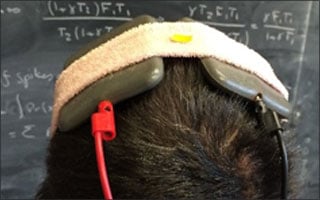Study finds Parkinson’s symptom improvement with non-invasive brain stimulation

In a recent pilot study, Reza Shadmehr, professor of biomedical engineering at the School of Medicine, and his team of Johns Hopkins researchers used brain stimulation to affectively improve motor symptoms in patients with Parkinson’s disease. Their research, Altering Effort Costs in Parkinson’s Disease with Noninvasive Cortical Stimulation, was recently published online in The Journal of Neuroscience.
Parkinson’s disease (PD), which affects up to one million Americans, tends to slow and decrease the intensity of movements even though the ability to move more quickly and forcefully is retained.
The researcher’s experiments stemmed from the knowledge that dopamine, the chemical released throughout the cortex of the brain by specialized neurons, is known to make animals more likely to exert effort to achieve a reward. In Parkinson’s, dopamine neurons generally die on one side of the brain, affecting the ability of the patient to exert effort with the opposite side of the body.
In urgent situations as simple as preventing a ball from falling off a table, for example, people with PD can often still make rapid, intense movements with their affected arm, but it seems as though the brain’s “cost assessment” for making everyday movements is abnormally high.
The researchers used an isometric task in which patients produced a goal force by engaging both arms, but were free to assign any fraction of that force to each arm. The patients preferred their less-affected arm, but only in some directions.
This preference was correlated with lateralization of signal-dependent noise: the direction of force for which the brain was less willing to assign effort to an arm was generally the direction for which that arm exhibited greater noise. Therefore, the direction-dependent noise in each arm acted as an implicit cost that discouraged use of that arm.
“The loss of dopamine associated with Parkinson’s disease makes the effort required to move the affected side of the body seem greater, so the brain is less willing to use that arm to complete tasks,” says Reza Shadmehr, senior author of the report. “Our study suggests that direct current stimulation can compensate somewhat for the loss of dopamine by decreasing the effort the brain has to put into getting its motor neuronsto fire.”
To check for a causal relationship between noise and motor cost, the researchers used bilateral transcranial direct current stimulation (tDCS) of the motor cortex, placing the cathode on the more-affected side and the anode on the less-affected side.
This stimulation not only reduced the noise on the more-affected arm, it also increased the willingness of the patients to assign force to that arm.
In both double-blind study and repeated stimulation studies, bilateral stimulation of the two motor cortices with cathode on the more-affected side reduced noise and increased the willingness of the patients to exert effort. This stimulation also improved the clinical motor symptoms of the disease.
“As far as we know so far,” Shadmehr cautions, “the effects of tDCS are very temporary, but that’s not surprising since no new dopamine cells are being created, which is the root of the problem.” Nevertheless, he says, “tDCS is a relatively simple, painless and inexpensive intervention that could be developed for home use, a device we are working on. It’s possible,” he adds, “that the brain would get used to the stimulation — just as it adjusts to medications — and also become less responsive over time, but we are hopeful that continued stimulation might improve symptoms.”
